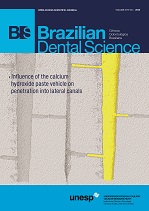The influence of disinfection on dimensional stability of temporary crowns
DOI:
https://doi.org/10.14295/bds.2018.v21i3.1573Abstract
Objective: Evaluate the influence of different disinfection methods on the dimensional stability of temporary acrylic resin crowns. Material and Methods: A metallic die with two different marks at the margin was used to prepare the specimens with two different resins (bis-acrylic resin-Structur, acrylic resin-Dencrilay). They were divided into eight groups (n=8), determined according to the disinfection methods (microwave, acetic acid, 1% hypochlorite) and control. The marginal adaptation was recorded using an optical microscope (50X) comparing two different marks on the margin of the crowns with 2 points along the entire circumferential margin before and after disinfection methods. Results: Results were compared statistically by ANOVA and Tukey's test (p?0.05). The two-way ANOVA showed statistical difference between types of materials. No significant differences were found between disinfection methods and interaction of factors. Conclusion: All procedures affected the marginal adaptation however temporary crowns made by bis-acrylic resin demonstrate higher dimensional stability.
Keywords
Dimensional stability; Disinfection; Temporary crowns.
Downloads
Downloads
Published
How to Cite
Issue
Section
License
Brazilian Dental Science uses the Creative Commons (CC-BY 4.0) license, thus preserving the integrity of articles in an open access environment. The journal allows the author to retain publishing rights without restrictions.
=================




























